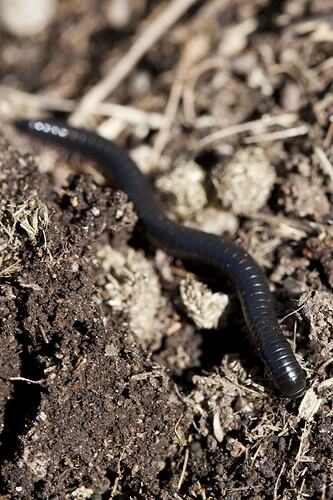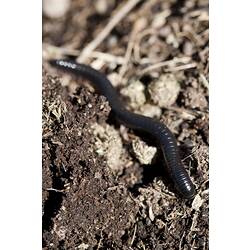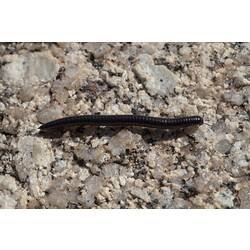General Description
A species of millipede with 50 body segments and 2 pairs of legs on each segment. These millipedes curl up in a tight spiral or thrash around if you try to pick them up. They can also exude a distasteful chemical designed to make them unpalatable to predators. Shiny dark grey to black in colour with lighter coloured legs. The juveniles are a light grey or brown colour. Body length up to 4.5 cm.
Biology
This species was introduced to Australia in the 1950's and since then has spread widely through south-eastern Australia, Tasmania and into south-western Australia. Native millipedes play an important role in the environment, helping to break down plant matter releasing nutrients back into the environment. The Portuguese Millipede however is a serious pest in Australia. As a result of its attraction to lights and ability to build up huge populations, this species often invades homes and buildings in large numbers. In Victoria this species has been responsible for stopping train services between Melbourne and Ballarat. Millions of the millipedes are crushed on the train tracks to the point where the trains are unable to gain traction. The Portuguese Millipede lays its eggs in autumn and the species takes about 2 years to reach reproductive maturity. Further research is required to determine what impact this species is having on native millipedes and other invertebrates.
Distribution
Southern mainland Australia.
Habitat
Can be found in woodlands, gardens and likes areas with leaf litter.
More Information
-
Animal Type
-
Animal SubType
-
Brief Id
Two pairs of legs on most segments, about 50 body segments long.
-
Colours
Black, Grey
-
Maximum Size
4.5 cm
-
Habitats
-
Where To Look
-
Diet
Herbivore
-
Hazards
This introduced millipede is a pest but is not dangerous.
-
Endemicity
-
Commercial
No
-
Conservation Statuses
CITES: Not listed, EPBC Act 1999: Not listed, FFG Threatened List: Not listed, IUCN Red List: Not listed
-
Taxon Name
-
Scientific Author
(Lucas, 1860)
-
Common Name
Black Portugese Millipede
-
Kingdom
-
Phylum
-
Subphylum
-
Class
-
Order
-
Family
-
Genus
-
Species Name
moreleti


